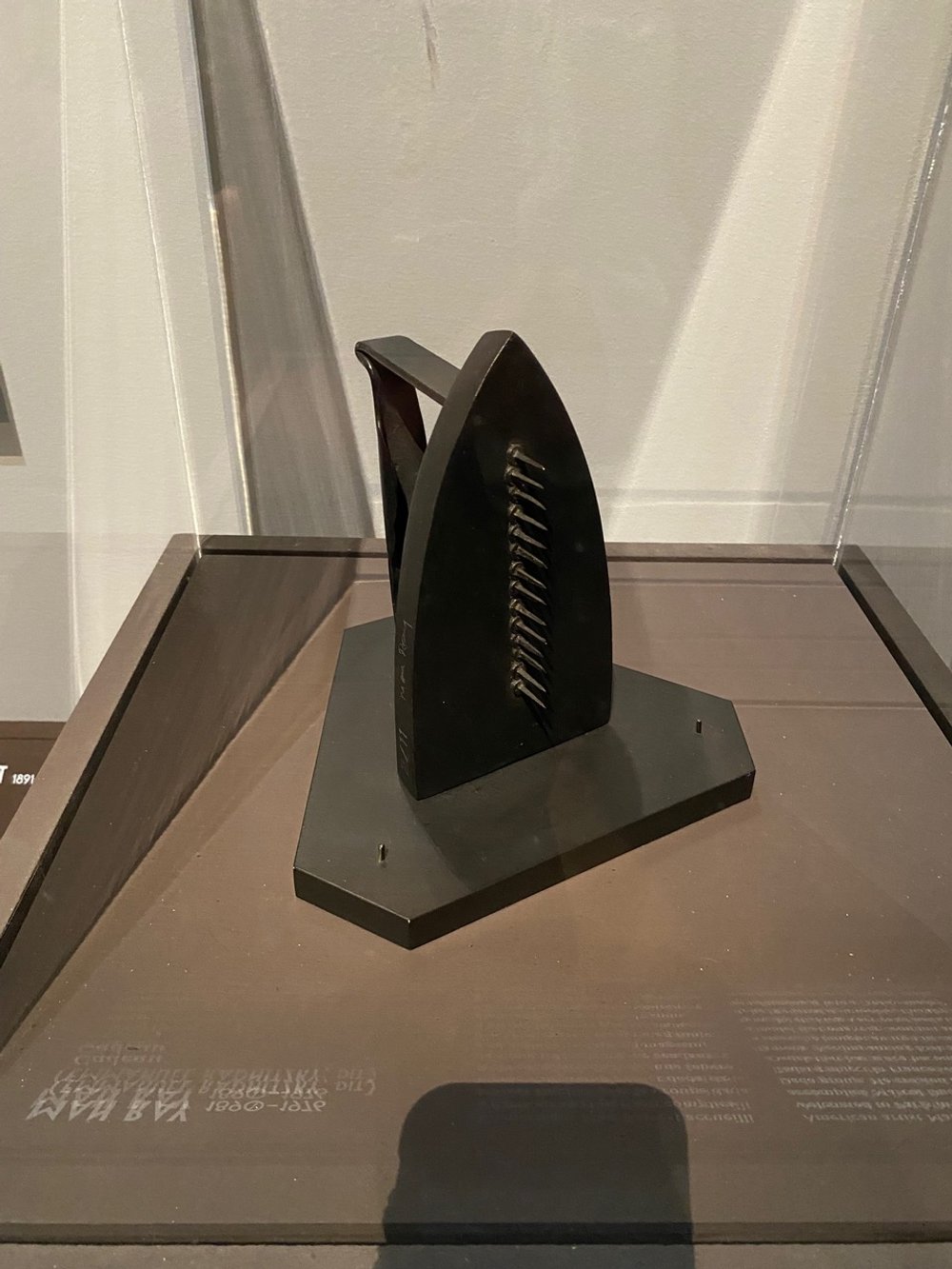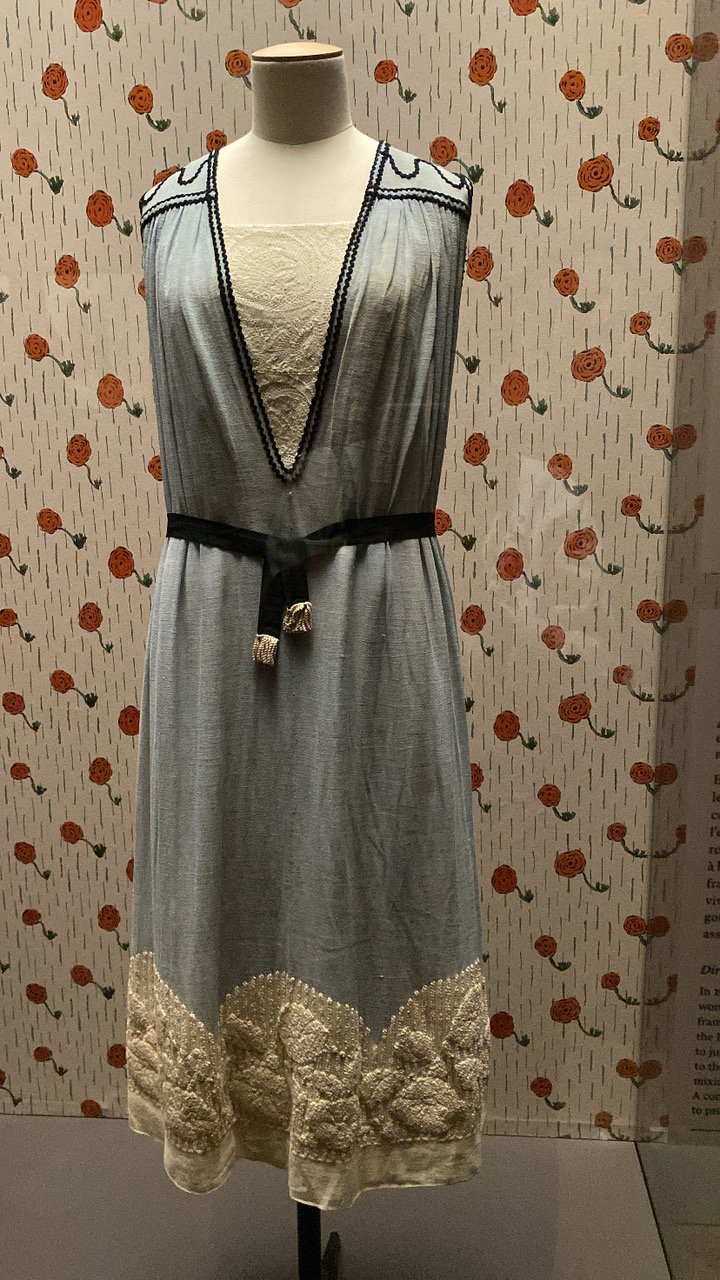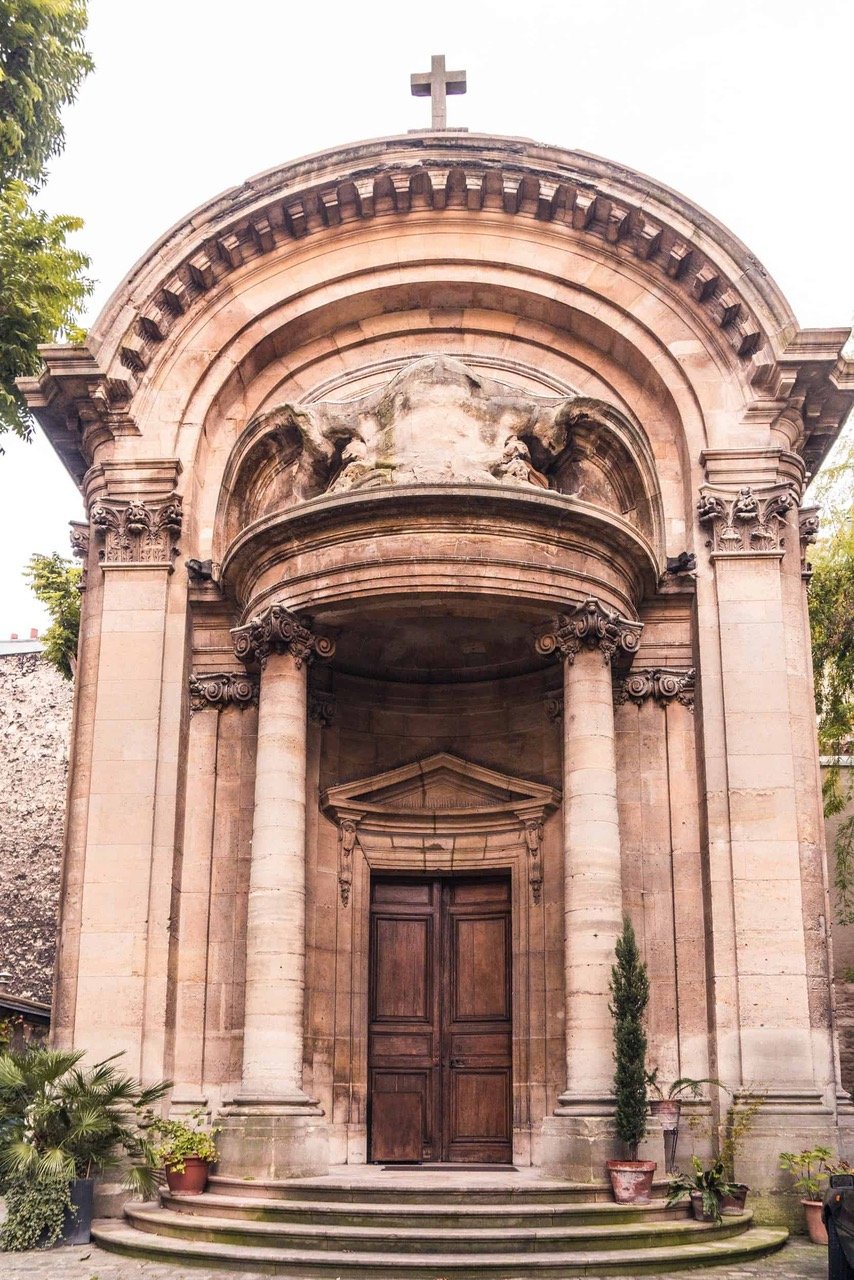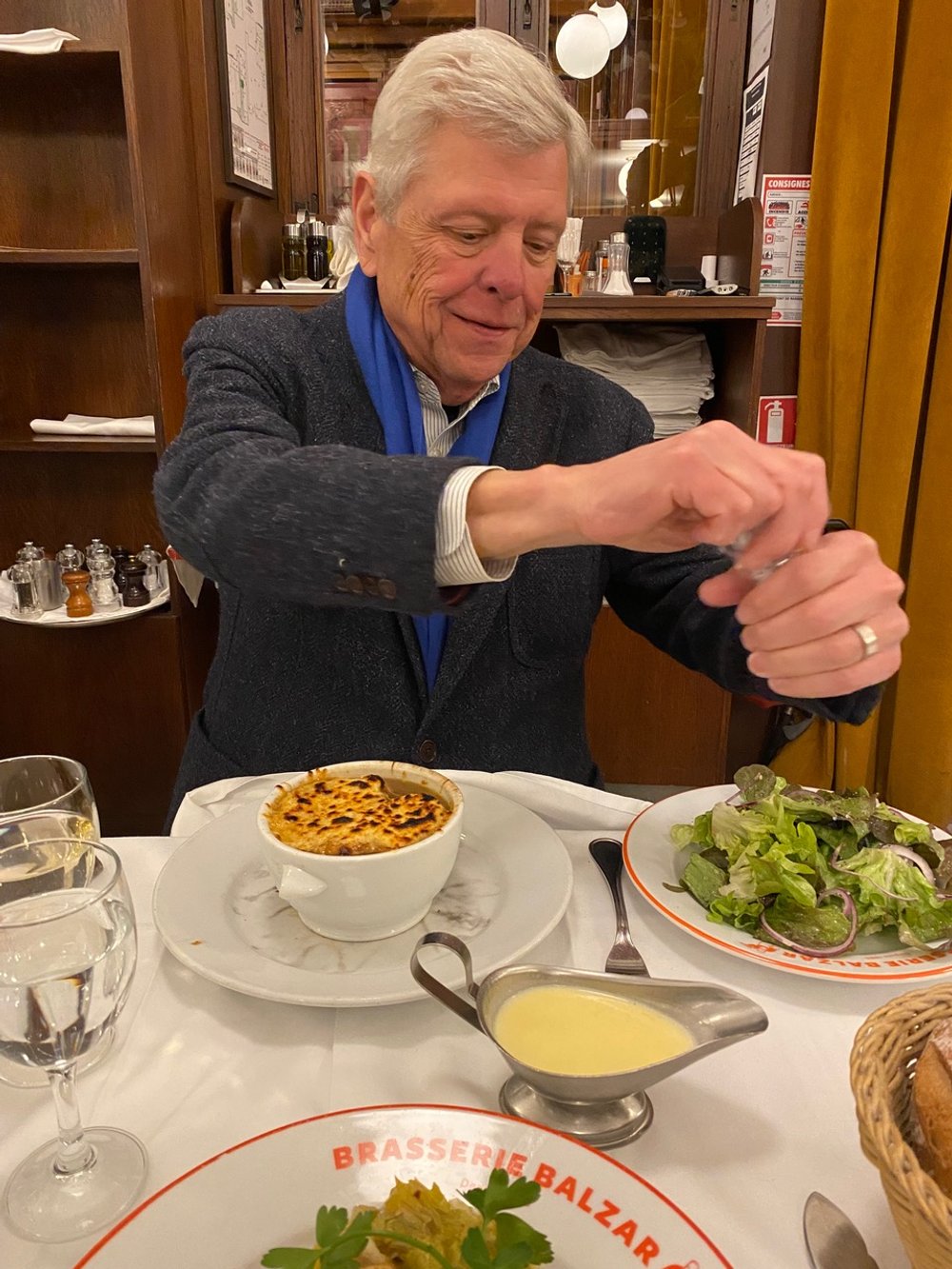New Places with an Old Friend
Newsletter 03.03.2024
Bienvenue and welcome back to Musée Musings, your idiosyncratic guide to Paris and art. This week it’s more performing and culinary arts than plastic arts - you have to report the stories where you find them! And yes, to those of you who noticed, there was something missing from my Proust report last week. Madeleines, bien sûr! To relieve your mind and set the record straight, I had one of the best Madeleines I have ever tasted at the Grand Hotel in Cabourg. It came with the pot of coffee and pot of warm milk that I decadently ordered from room service. (Fig 1)
Figure 1. The ‘Madeleine’ at the Grand Hotel, Cabourg
Okay, back to this week’s news. I received an email from my friend Bobby when I was still in San Francisco. Would I be in Paris the 3rd week of February. And if so, would I have time for a meal. Yes and yes. With pleasure! I met Bobby in 2018, we were both living our dreams. Mine of moving to Paris indefinitely. His of taking a six month sabbatical from work (with his wife’s blessings) to live in Paris. We first met at one of Terrance’s Sunday morning get togethers. We cemented our friendship at a soirée at which Martin Walker talked about his small town Dordogne Chief of Police, Bruno. (Fig. 2) and his own red wine, also named Bruno. I brought home an empty bottle as a souvenir, but, alas, it has since disappeared.(Fig. 3)
Figure 2. Martin Walker & me, in Bergerac a few years after the soirée in question
Figure 3. Martin Walker’s own red, named Bruno, of course, with Bruno’s hound standing watch
As Bobby, a true southern gentleman, walked me to my metro station after the soiree, (the one given in my life is I have no sense of direction, and in 2018, I had no idea how to use my cell phone’s GPS), we decided to meet up the next week and go to a museum. He suggested the Atelier des Lumières, which had just opened its doors in Paris. We would see their inaugural show on the artist Gustav Klimt. I suggested lunch beforehand at Merci. Living in the 16th arrondissement as I was at the time, going into the Marais and to Merci was a special treat. Now the Marais is my neighborhood and Merci is just down the street from where I live. Life is sweet.
Do you know Merci? (Fig. 4) It’s a stand alone department store which opened 15 years ago (2009), on Boulevard Beaumarché, in a 19th century building that had housed a wallpaper and fabric manufactory. Merci is not as upmarket as that other stand alone store, Colette, was. (Fig. 5) But Merci is no Macy’s. There’s definitely not a ‘something for everyone’ vibe. It carries a curated collection of fashion and furnishings. According to its website, Merci is “(d)esigned to be welcoming rather than intimidating, based around conviviality and pleasure. (M)ore than a store,.. (it’s) a place to go for its unique atmosphere and the pleasurable experience it offers.”
Figure 4. Front of Merci, on Boulevard Beaumarchais, with mascot red Fiat 500
Figure 5. Colette (trendiest store in world, Forbes), rue Saint-Honoré. It closed after 20 years, by choice not necessity
At the time, there were several restaurants and cafés in Merci. One was in a small space on the ground floor, with shelves of books lining the walls. (Fig 6) You felt as if you were eating in someone’s library. But I wanted to eat downstairs, in a space that opened out onto the store’s own potager (kitchen garden). They served the most inventive salads there. (Fig 7) Sure, they offered other dishes, heartier dishes, but I loved those salads. You could get a plate of three, which is what I always did. I still have paper placemats from all the lunches I ate at Merci over the years on which I scribbled the ingredients of the salads I ate that day. It was here that I first learned to appreciate watermelon with feta and green beans with grains.
Figure 6. Library (bibliothèque) Café, Merci
Figure 7. Potager Café, Merci
Lunch and museum became a weekly event. I can’t remember all the exhibitions we saw, but among them was a Rodin and Dance exhibition at the Musée Rodin and a multi artist exhibition at the Fondation Louis Vuitton. Lunch at the Fondation’s Restaurant Le Frank (named after Frank Gehry, the building’s architect) was one of my favorites. (Figs 8, 9) All those happy memories came flooding back when I got Bobby’s email. I hadn’t seen him in Paris since 2018. He and his wife had been scheduled to come to Paris in 2020. I was planning to take them to the fantastic exhibition on Christian Louboutin shoes, but they had to cancel their trip because of Covid. A couple years later, they did make it to Paris, but I had already left for San Francisco. I did catch up with them again, nearly two years ago now, in St. Emilion. Which is beautiful but which isn’t Paris.
Figure 8. Lunch at Restaurant Le Frank, Fondation Louis Vuitton
Figure 9. Bouillon Pigalle, before a visit to Musée de la vie Romantique, by which time Ginevra had joined me in Paris.
I asked Bobby if he wanted to go back to the Atelier des Lumières, a show on Egypt of the Pharaohs had just opened. We agreed that going someplace where we didn’t have to actually concentrate was a good idea. The exhibition certainly was immersive. (Figs 10, 11) We didn’t really learn anything but then again, we weren’t wandering through a museum exhibition chatting and bothering other people. Our lunch beforehand, at the restaurant I selected, which I have enjoyed in the past, was a disappointment, so I won’t mention the name. I was proud and Bobby was impressed that I got us from the restaurant to the Atelier, a 30 minute walk. I only looked at my GPS only once, at the end, to answer that perennial question, should I turn right or left. When I easily got Bobby to his metro stop (I’m a real native now), I bade him farewell with a happy heart, we had plans to meet up again later in the week.
Figure 10. Egypt of the Pharaoh, Atelier des Lumières, Paris
Figure 11. Egypt of the Pharaoh, Atelier des Lumières, Paris
On Wednesday I decided that I had to see the exhibition at the Petit Palais which had opened too late for me to see it in November. Called ‘Le Paris de la Modernité’ (Modern Paris 1905 - 1925), (Fig 12) it was exhaustive and exhausting. It included everything and the kitchen sink, actually several kitchen sinks. It could easily have been three exhibitions, maybe more. The last exhibition I saw at the Petit Palais was on Sarah Bernhardt. Which was also unbelievably wide in scope, but at least everything revolved around one topic, the diva herself.
Figure 12. Le Paris de la Modernité, (Modern Paris) Petit Palais, Paris
The three topics covered in this exhibition are: the Belle Époque, 1905-1914; the War Years, 1914-1918; and the Années Folle, (Roaring Twenties), 1919-1925. The exhibition offered a 20 year who’s who of artists, from Robert and Sonia Delaunay to Marcel Duchamp and Man Ray; from Jacqueline Marval and Marie Laurencin to Tamara de Lempicka and Marie Vassilieff. Obviously Picasso was here as were Soutine, Modigliani and Chagall. Oh, and Josephine Baker, too. I was happy to see two sculptures by Chana Orloff whose exhibition at the Musée Zadkine I had just seen.
The exhibition would have been too much if it had only been about painters and sculptors. But it wasn’t, there were dress designers like Paul Poiret and Jeanne Lanvin. And every so often, there was a case of priceless jewelry from Cartier (not surprisingly, Cartier was an exhibition sponsor). And there’s more - a plane from Le Bourget Musée de l’Air et de l’Espace, and a car from the Musée national de l’Automobile in Mulhouse. As the museum website states, “(t)hrough fashion, cinema, photography, painting, sculpture, and drawing, as well as dance, design, architecture, and industry, this exhibition showcases the rich creativity of the period 1905-1925.” Whew! (Figs 13 - 19)
Figure 13. Saint-Moritz, Tamara de Lempicka, 1929
Figure 14. Josephine Baker, Kees van Dongen, 1925
Figure 15. ‘Parade’ Ballet by Jean Cocteau & Eric Satie, Costume by Pablo Picasso, 1917
Figure 16. One of many Cartier display cases
Figure 17. Airplane from Le Bourget Musée de l’Air et de l’Espace
Figure 18. Cadeau (gift) Ready Made, Man Ray, purchased iron made of iron with nails applied, 1917
Figure 19. Dress, Paul Poiret, 1920s
I knew all of the artists in this exhibition. I have seen many of their works in the last few years at temporary exhibitions with more focused themes. Like “Chagall, Modigliani, Soutine…Paris for School, 1905-1940” at the Museum of the Art and History of Judaism (MahJ) about the artists who, fleeing oppression in Russia and eastern Europe, arrived in Paris between 1900-1914. There was an exhibition at the Musée Luxembourg called Pionnières, about the women of the Années Folles, (Garconnes in French and Flappers in English). Of course, there were the exhibitions about Proust and the Belle Époque, to celebrate his birth/death dates. Picasso on both sides of the First World War was the theme of exhibitions before and during the 50th anniversary of his death. At the Musée d’histoire d’immigration an excellent exhibition considered Picasso as a foreigner. At the Musée de l’homme the topic was Picasso’s fascination with prehistoric art.“The Invention of Language: Gertrude Stein and Pablo Picasso” was at the Musée du Luxembourg. An exhausting exhibition to be sure. For me at least, it was an interesting refresher course.
Bobby and I met up again on Thursday evening. He had booked a concert at Eglise Saint-Ephrem, (Fig 20) in the 5th arrondissement, just below the Pantheon. I had never heard of this church, although I have certainly walked by it. We decided to meet an hour early for an apero before the concert. It’s something that I, as a woman living alone, never do. Despite gale force winds and blinding rain, I braved the elements and by the time I walked out of the metro, both rain and wind were gone. At the restaurant Bobby selected for our apero, La Petite Périgordine, (Fig 21) we each had a glass of wine. I was feeling peckish, so the waiter brought us some thin slices of sausage and big chunks of baguette. Even though we were only there for a quick drink, we were graciously welcomed and promptly served. The bill was 15€, about the price of one glass of wine in San Francisco, before tax and tip.
Figure 20. Eglise Saint Ephrem le Syriaque, rue des Carmes, 5th arrondissement, Paris
Figure 21. La Petite Périgourdine, rue des Ecoles
The concert was delightful. A violinist accompanied by a pianist (or maybe it was the other way around) played selections from six different composers, among them, Elgar and Fauré. It was a candlelight concert, which meant that the darkened sanctuary twinkled with candle filled candelabras. (Fig 22) The church was surprisingly warm - I always expect churches to be freezing because they usually are. Afterwards, we walked over to one of Bobby’s favorite brasseries, Balzar. Bobby wanted soup and salad and I wanted a main. As Bobby struggled with the cheese on his onion soup, (Figs 23, 24) I daintily ate my lightly seasoned fish (maybe cabillaud) and delightfully creamy leeks. We shared an ile flottante the perfect light dessert . As we said goodbye, Bobby promised that he and Meredith would be in Paris soon.
Figure 22. Concert at Saint Ephrem le Syriaque, rue des Carmes
Figure 23. Bobby at Brasserie Balzar, before tackling his onion soup
Figure 24. My delicious and delicate dish of Cabillaud and poireaux (leeks) at Brasserie Balzar
Bobby’s wasn’t the only email invitation I received in January. The Operas de Paris sent me an email inviting me to purchase reduced price tickets on a few of their spring offerings at the Opera de la Bastille. My first opera was Friday night, a fifth row center seat for an opera called Beatrice di Tenda by Vincenzo Bellini. (Fig. 25) I chose this opera not because of Bellini, nor because of the opera, about which I knew nothing. I chose it because I wanted to experience an opera directed by Peter Sellars. Are you familiar with Sellars? (Fig. 26) He’s the master of quirky, irreverent and avant-garde stagings of classical and contemporary operas and plays. I’ll tell you about that the opera next week. Gros Bisous! Dr. ‘B.’
Figure 25. Beatrice di Tenda, Opera de la Bastille, Paris
Figure 26. Peter Sellars, Director, Beatrice di Tenda, Opera de la Bastille, Paris
Copyright © 2024 Beverly Held, Ph.D. All rights reserved
Dear Reader, I hope you enjoyed reading this article. Please sign up below to receive more articles plus other original content from me, Dr. B. Merci!
And, if you enjoyed reading this review, please consider writing a comment. Thank you!


























